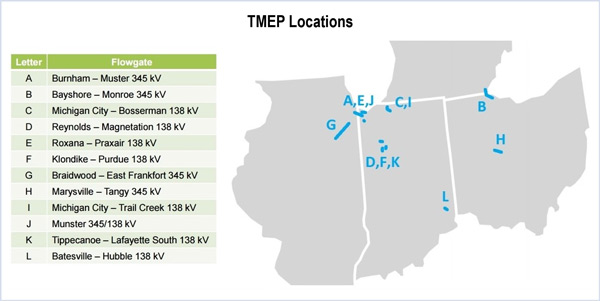By Amanda Durish Cook
CARMEL, Ind. — MISO and PJM are close to implementing a targeted market efficiency project (TMEP) type and poised to approve six such projects with cross-regional benefits.
During the Nov. 15 MISO and PJM Joint and Common Market meeting, Jesse Moser, MISO manager of infrastructure studies, said the RTOs must make a FERC filing to change their joint operating agreement in addition to individual filings on how they plan to handle cost allocation.
Moser said the RTOs prefer making the necessary three filings simultaneously, but they would file standalone JOA changes before the end of the year if certain regional cost allocation details are not finalized in time.
“We’re happy to see this move forward,” Moser said.
The two RTO’s staff say the final six projects are expected to cost about $17.25 million and deliver $111.6 million in reduced congestion on market-to-market flowgates, an average 6.5:1 benefit-to-cost ratio.
The RTOs examined 50 market-to-market flowgates and produced the final six from a pool of 13 potential upgrades. The final six exclude the previously recommended Klondike-Purdue 138-kV project in north-central Indiana, which did not advance because of the discovery that the congestion the project was designed to relieve was outage-driven. (See 7 Sites Eyed for MISO-PJM Targeted Market Efficiency Projects.) “These are meant to be lower cost projects … that have near-term economic benefits,” Moser explained.
MISO to Seek Bifurcated Cost Allocation

At a Nov. 17 conference call of MISO’s Regional Expansion Criteria and Benefits Working Group, transmission engineer Adam Solomon said the RTO will pursue a bifurcated cost allocation for the TMEPs. MISO proposes to assign cost to a local transmission pricing zone when the constraint is on the transmission of one or more transmission owners. For constraints wholly within PJM, MISO is seeking a postage stamp allocation for all of the MISO North region.
Solomon said MISO decided on a postage stamp for projects within PJM because all local transmission pricing zones would gain from lowered congestion.
PJM officials did not discuss their cost allocation plans at the meeting. Spokeswoman Paula DuPont said the regional cost allocation is being developed by PJM’s Transmission Owners Agreement-Administrative Committee.
The two-option proposal would apply to both RTO’s current batch of TMEPs. “We’re certainly open to looking at it in the future if we can get a better cost allocation,” Solomon said.
Shelly-Ann Maye, representing Midwest Power Transmission Arkansas, said she didn’t understand why a postage stamp allocation could be justified when local beneficiaries in MISO could be identified.
“These projects are avoiding future congestion in MISO, and that congestion gets pretty well spread out in the footprint,” Solomon explained.
Of the six TMEPs currently being considered, the Marysville-Tangy 345-kV project in central Ohio is the only project that would qualify for the postage stamp allocation, as it is located wholly within PJM, Solomon said.
Solomon also said the cost allocation rules will only apply to the PJM-MISO seam. MISO staff said they plan to collect more SPP day-ahead market-to-market information and expect to begin discussions with SPP on a similar project type.
“Having this cost allocation spelled out in the JOA and Tariff, I think, will help these projects go through and we can get the benefit of those projects we’re forecasting,” Solomon said.
Wisconsin Public Service’s Chris Plante said his utility was hoping for 50% local pricing zone allocation and 50% postage stamp allocation for all TMEPs.
“We think this is the best proposal that we have at this point with stakeholder feedback considered,” Solomon said.
Retirement Coordination
Neil Shah, MISO adviser of seams administration, also said that both RTOs are planning to file a generator retirement coordination process with FERC by Dec. 15. Shah said the final language was largely unchanged from what was proposed last month. (See MISO Outlines Retirement Coordination with PJM.)






